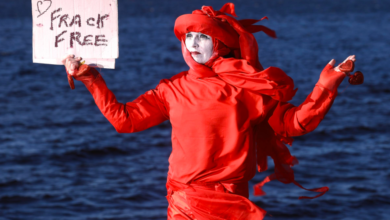Ethno-nationalism was Basis of Building Soviet States
One of the factors thought to have led to the break-up of the Soviet Union was the reemergence of ethno-nationalism. However, ethnic identity was purposely cultivated during the Communist Revolution of 1917 to overthrow the Russian aristocracy, said visiting scholar Yuri Urbanovich at a conference on “Russia in Turmoil” March 6 through 8, sponsored by the University’s Division of Continuing Education and the Center for Russian and East European Studies.
Even under totalitarian Communist rule, many people continued to identify most strongly with their ethnic groups.
“Lenin and the Bolsheviks (unlike their political opponents who stood for a `one and undivided’ Russia) used the slogan of the right to self-determination as a tremendously effective political weapon in winning the non-Russian regions to their side,” said Mr. Urbanovich, who is working with U.Va.’s Center for the Study of Mind and Human Interaction.
The center, which employs a psychological approach to solving ethnic conflicts, will wrap up a project this April of bringing together politicians from Russia and the Baltic states to work out differences and improve political and economic relations.
An associate professor and Director of Special Projects in the Russian Ministry of Foreign Affairs, Mr. Urbanovich said the principle of ethno-nationalism enabled the peoples of the Baltic region to establish their own independent states (of Latvia, Lithuania and Estonia) in the early years, as did Poland and Finland. It was only later that most of them fell prey to Stalin’s regime, he said.
“Ethno-nationalism became the basis on which socialist federalism was constructed.” The Communist notion of an international proletariat solidarity remained a utopian ideal, according to Mr. Urbanovich. The Soviet Union was formally composed of “ethno-political administrative units in which each indigenous socialist nation had its own statehood.” For instance, under the Soviet Union, internal passports included a person’s ethnicity. Each nation’s constitution included the right to secession, he said.
Nevertheless, some ethnic groups were favored over others. In areas that did not fit into neat ethnic borders, minorities were discriminated against.
The socialist states based on ethnic groups could only be kept together “under conditions of an emerging totalitarianism,” Mr. Urbanovich asserted. “This developed within the context of one-party rule and strict centralization enforced from Moscow, beginning with the first years of industrialization.” But inefficient administration on some local levels gave free rein to powerful individuals and clans, some of whom were connected to Mafia-like criminal groups.
Ethno-nationalism also emerged in place of the strong, centralized government, because “the Soviet state, with its isolated and sluggish economy, has proved, unlike its modern capitalist competitors, to be incapable of creating an influential and essentially internationalist social force like the Western business elite,” said Mr. Urbanovich.
When the government weakened, there was nothing stronger than ethno-nationalism to take its place. “There is an inherent disintegrating quality to using ethnicity as a basis of political structure.
Because of the inability of the political order to create civil institutions that worked effectively, ethnic group identification and nationalism became the way for Soviet citizens to rebel against conditions of social despair,” he said.
In fact, though, one challenge all of the newly independent states have in common is dealing with their truly multi-ethnic character, maintained Mr. Urbanovich. The Russian presence in the Baltic states provides one example. Russians have emigrated to the three nations since the 17th century, when they moved there to avoid religious persecution. Over the generations, those people have become part of the local society, unlike members of the Russian nobility who sought refuge in Lithuania after the Revolution or the Soviet army, installed there after World War II.
In Estonia, Russians make up a third of the population and have an exclusive enclave within the borders. “Both parties have to change. Russians have to understand that they are citizens of another state and Estonians have to understand the Russians are citizens, too,” Mr. Urbanovich said. In Latvia almost half the people are Russian.
Russians have become scapegoats blamed for the problems left by the Soviet Union, but other ethnic groups were equally strong Soviets, he said. “Before World War II, many KGB officers were Latvian,” as was Lenin’s personal guard, he said. “If you ask me, `What does it mean to be Russian today?’ I can’t answer you,” said Mr. Urbanovich, who has Lithuanian and Armenian roots but grew up in Georgia and Russia. Under 75 years of Soviet rule, Russian identity, destroyed during the Revolution, became Soviet identity, which is now a thing of the past. “Changing or re-establishing one’s identity is a painful process,” he said.





